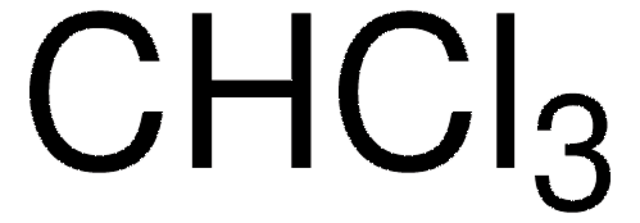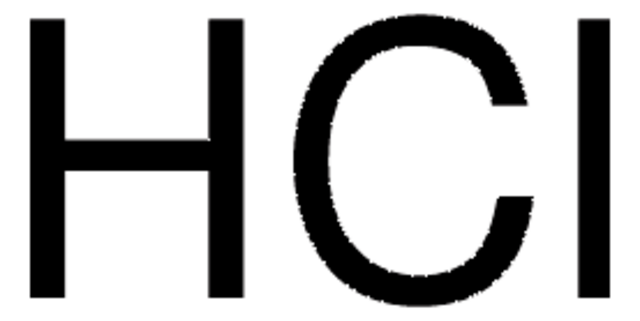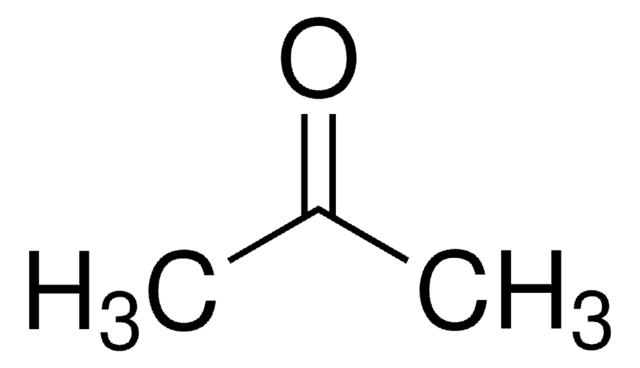32211-M
Chloroform
puriss. p.a., reag. ISO, reag. Ph. Eur., 99.0-99.4% (GC)
Synonym(s):
Methylidyne trichloride, Trichloromethane
About This Item
Recommended Products
Agency
USP/NF
reag. ISO
reag. Ph. Eur.
vapor density
4.1 (vs air)
vapor pressure
160 mmHg ( 20 °C)
grade
puriss. p.a.
Assay
99.0-99.4% (GC)
form
liquid
contains
~1% ethanol as stabilizer
technique(s)
RNA extraction: suitable
impurities
≤0.00001% free chlorine (Cl)
≤0.00005% free acid (as HCl)
≤0.0005% non-volatile matter
≤0.005% aldehydes and ketones (as CH3COCH3)
≤0.005% carbonyl compounds (as CO)
≤0.01% tetrachloroethene (GC)
≤0.01% tetrachloromethane (GC)
≤0.01% trichloroethene (GC)
≤0.01% water (Karl Fischer)
≤0.03% dichloromethane (GC)
0.6-1.0% ethanol (GC)
refractive index
n20/D 1.445 (lit.)
bp
60.5-61.5 °C (lit.)
mp
−63 °C (lit.)
density
1.476-1.483 g/mL at 20 °C
1.492 g/mL at 25 °C (lit.)
anion traces
chloride (Cl-): ≤0.0001%
cation traces
Al: ≤0.50 ppm
B: ≤0.02 ppm
Ba: ≤0.10 ppm
Ca: ≤0.50 ppm
Cd: ≤0.05 ppm
Co: ≤0.02 ppm
Cr: ≤0.02 ppm
Cu: ≤0.02 ppm
Fe: ≤0.10 ppm
Mg: ≤0.10 ppm
Mn: ≤0.02 ppm
Ni: ≤0.02 ppm
Pb: ≤0.05 ppm
Sn: ≤0.10 ppm
Zn: ≤0.10 ppm
SMILES string
ClC(Cl)Cl
suitability
complies for appearance
complies for reaction against H2SO4
complies for suitability of determ. w. dithizone
InChI
1S/CHCl3/c2-1(3)4/h1H
InChI key
HEDRZPFGACZZDS-UHFFFAOYSA-N
Looking for similar products? Visit Product Comparison Guide
General description
Application
- Extraction of RNA from plant cells.
- Preparation of dioleoylphosphatidylcholine (DOPC) solution.
- Dissolution of 1,2-distearoyl-sn-glycero-3-phosphocholine (DSPC).
Other Notes
Chloroform Miscibility/Immiscibility Table
Signal Word
Danger
Hazard Statements
Precautionary Statements
Hazard Classifications
Acute Tox. 3 Inhalation - Acute Tox. 4 Oral - Carc. 2 - Eye Irrit. 2 - Repr. 2 - Skin Irrit. 2 - STOT RE 1 Oral - STOT SE 3
Target Organs
Central nervous system, Liver,Kidney
Storage Class Code
6.1D - Non-combustible acute toxic Cat.3 / toxic hazardous materials or hazardous materials causing chronic effects
WGK
WGK 3
Flash Point(F)
does not flash
Flash Point(C)
does not flash
Regulatory Information
Choose from one of the most recent versions:
Already Own This Product?
Find documentation for the products that you have recently purchased in the Document Library.
Our team of scientists has experience in all areas of research including Life Science, Material Science, Chemical Synthesis, Chromatography, Analytical and many others.
Contact Technical Service








